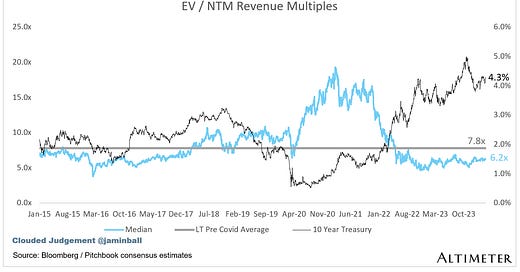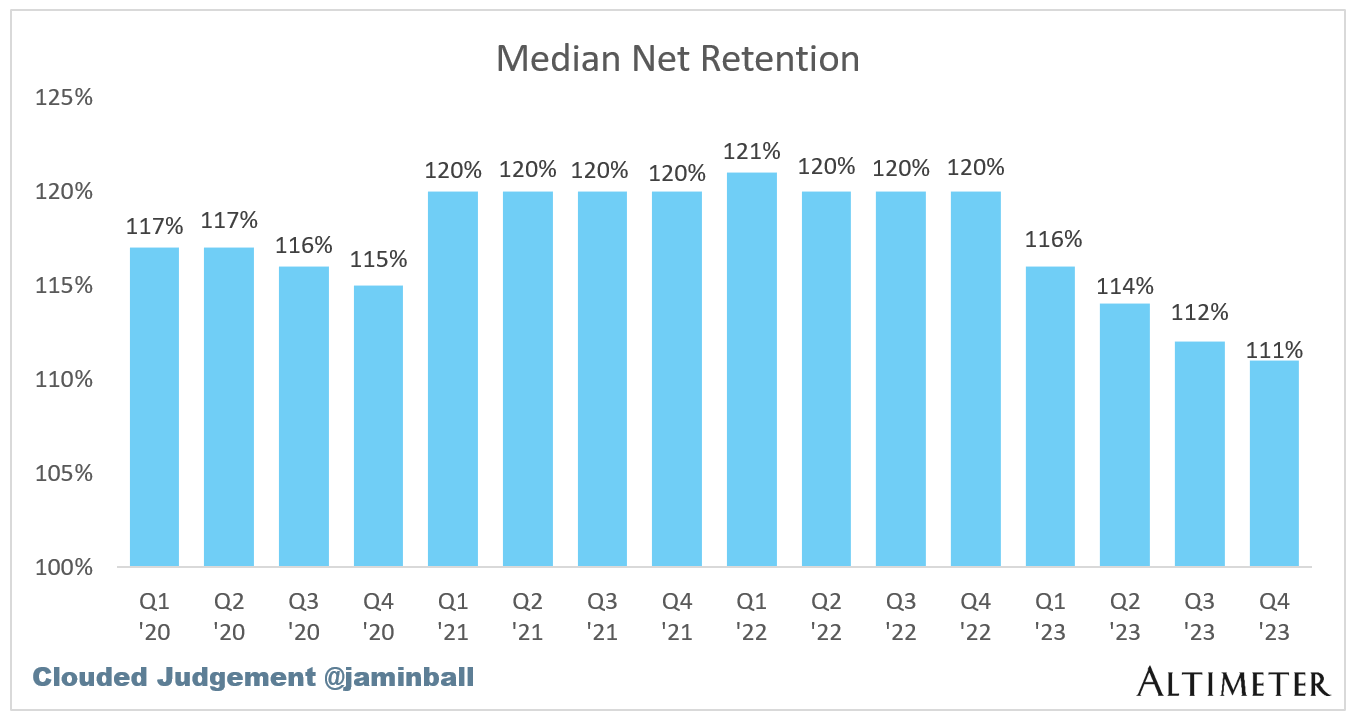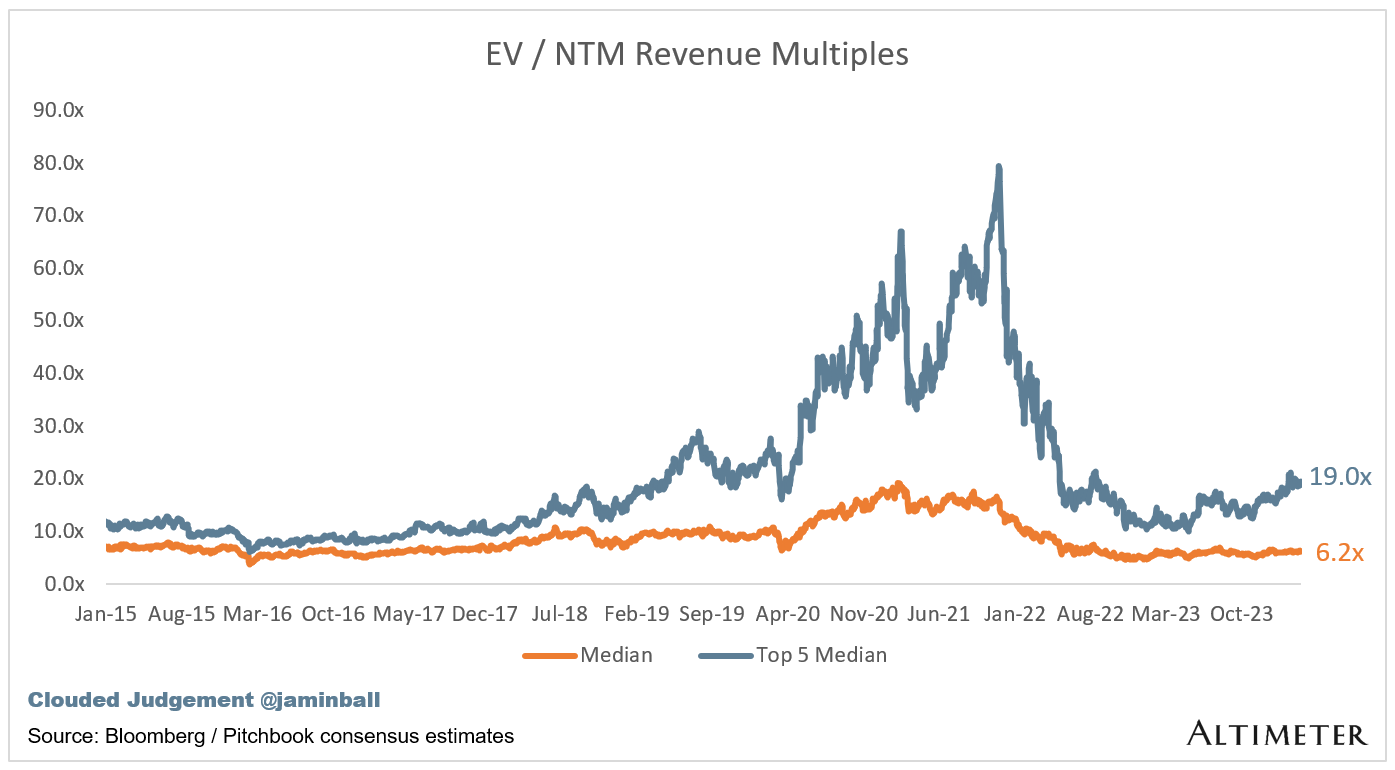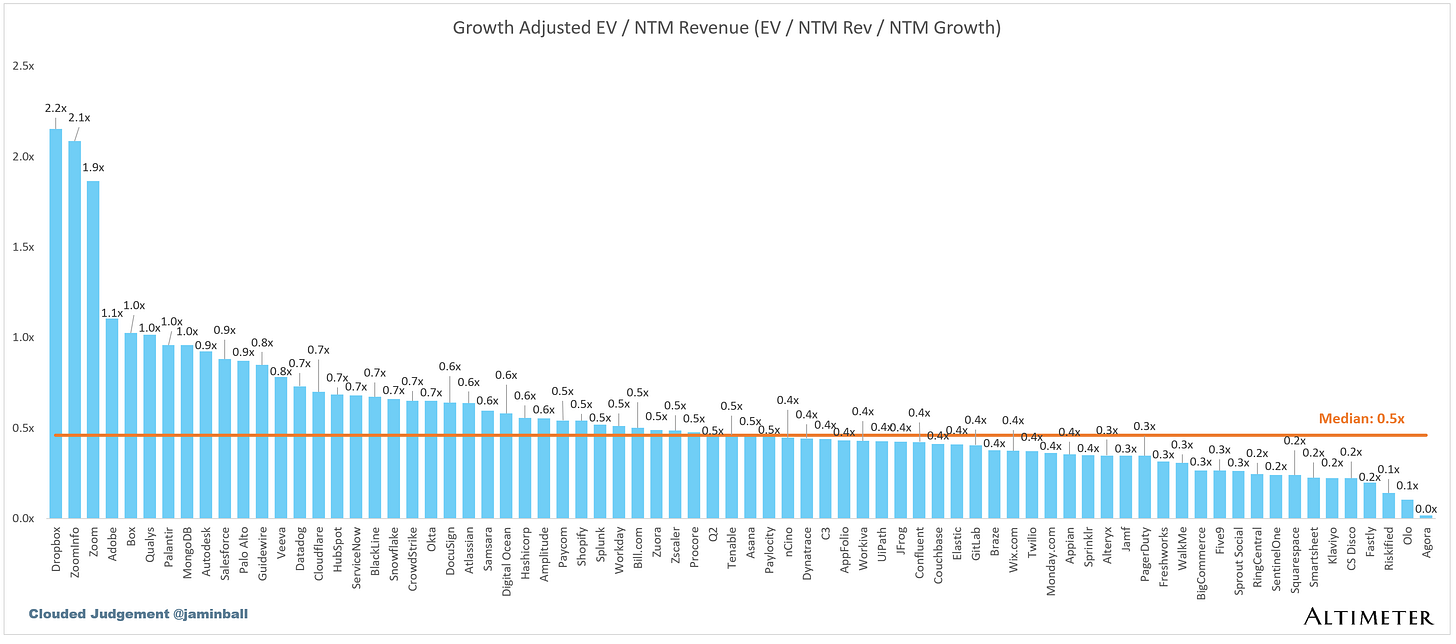Every week I’ll provide updates on the latest trends in cloud software companies. Follow along to stay up to date!
Q4 ‘23 Earnings Summary Preview
We’re almost through Q4 ‘23 earnings season with just a few stragglers left to report (Braze, nCino, Sprinklr). I’ll put together my standard deeper dive quarterly review, but wanted to share some high level summary charts today.
Let’s start with Q4 YoY growth. Quarterly YoY growth is still decelerating, but the rate of change is starting to slow down
Similarly, the median net retention is still falling
FCF margins continue to expand, with the median FCF margin in Q4 hitting nearly 20%
And finally, the CAC payback period. It’s started to level off, but still remains elevated
Quarterly Reports Summary
Top 10 EV / NTM Revenue Multiples
Top 10 Weekly Share Price Movement
Update on Multiples
SaaS businesses are generally valued on a multiple of their revenue - in most cases the projected revenue for the next 12 months. Revenue multiples are a shorthand valuation framework. Given most software companies are not profitable, or not generating meaningful FCF, it’s the only metric to compare the entire industry against. Even a DCF is riddled with long term assumptions. The promise of SaaS is that growth in the early years leads to profits in the mature years. Multiples shown below are calculated by taking the Enterprise Value (market cap + debt - cash) / NTM revenue.
Overall Stats:
Overall Median: 6.2x
Top 5 Median: 19.0x
10Y: 4.3%
Bucketed by Growth. In the buckets below I consider high growth >27% projected NTM growth (I had to update this, as the number of companies projected to grow >30% is now only 1 after this quarter’s earnings), mid growth 15%-27% and low growth <15%
High Growth Median: 10.0x
Mid Growth Median: 9.3x
Low Growth Median: 4.5x
EV / NTM Rev / NTM Growth
The below chart shows the EV / NTM revenue multiple divided by NTM consensus growth expectations. So a company trading at 20x NTM revenue that is projected to grow 100% would be trading at 0.2x. The goal of this graph is to show how relatively cheap / expensive each stock is relative to their growth expectations
EV / NTM FCF
The line chart shows the median of all companies with a FCF multiple >0x and <100x. I created this subset to show companies where FCF is a relevant valuation metric.
Companies with negative NTM FCF are not listed on the chart
Scatter Plot of EV / NTM Rev Multiple vs NTM Rev Growth
How correlated is growth to valuation multiple?
Operating Metrics
Median NTM growth rate: 13%
Median LTM growth rate: 17%
Median Gross Margin: 76%
Median Operating Margin (11%)
Median FCF Margin: 11%
Median Net Retention: 110%
Median CAC Payback: 38 months
Median S&M % Revenue: 42%
Median R&D % Revenue: 25%
Median G&A % Revenue: 16%
Comps Output
Rule of 40 shows rev growth + FCF margin (both LTM and NTM for growth + margins). FCF calculated as Cash Flow from Operations - Capital Expenditures
GM Adjusted Payback is calculated as: (Previous Q S&M) / (Net New ARR in Q x Gross Margin) x 12 . It shows the number of months it takes for a SaaS business to payback their fully burdened CAC on a gross profit basis. Most public companies don’t report net new ARR, so I’m taking an implied ARR metric (quarterly subscription revenue x 4). Net new ARR is simply the ARR of the current quarter, minus the ARR of the previous quarter. Companies that do not disclose subscription rev have been left out of the analysis and are listed as NA.
Sources used in this post include Bloomberg, Pitchbook and company filings
The information presented in this newsletter is the opinion of the author and does not necessarily reflect the view of any other person or entity, including Altimeter Capital Management, LP ("Altimeter"). The information provided is believed to be from reliable sources but no liability is accepted for any inaccuracies. This is for information purposes and should not be construed as an investment recommendation. Past performance is no guarantee of future performance. Altimeter is an investment adviser registered with the U.S. Securities and Exchange Commission. Registration does not imply a certain level of skill or training.
This post and the information presented are intended for informational purposes only. The views expressed herein are the author’s alone and do not constitute an offer to sell, or a recommendation to purchase, or a solicitation of an offer to buy, any security, nor a recommendation for any investment product or service. While certain information contained herein has been obtained from sources believed to be reliable, neither the author nor any of his employers or their affiliates have independently verified this information, and its accuracy and completeness cannot be guaranteed. Accordingly, no representation or warranty, express or implied, is made as to, and no reliance should be placed on, the fairness, accuracy, timeliness or completeness of this information. The author and all employers and their affiliated persons assume no liability for this information and no obligation to update the information or analysis contained herein in the future.






















Very interesting and useful stats on how Q4 earnings reports are shaping up against historical trends. RE: the median FCF margin chart…does it look similar or different if you plot $FCF per diluted share? I continue to believe that many hyper growth companies decided to make FCF and FCF margin their main investor facing talking point, while making excuses for slower growth along with continued high SBC expenses. “See how much free cash flow we generated in each quarter in 2023?”…meanwhile ignore that shareholder dilution and high SBC expenses. Cheers, Jamin.